Podcast
Questions and Answers
What is the primary function of the small intestine?
What is the primary function of the small intestine?
- Production of bile
- Secretion of digestive enzymes
- Absorption of water and electrolytes
- Nutrient absorption (correct)
Which part of the digestive system is primarily responsible for the formation and elimination of feces?
Which part of the digestive system is primarily responsible for the formation and elimination of feces?
- Pancreas
- Small Intestine
- Large Intestine (correct)
- Liver
What role do hormones like gastrin, secretin, and cholecystokinin serve in gastrointestinal function?
What role do hormones like gastrin, secretin, and cholecystokinin serve in gastrointestinal function?
- Control blood flow to the digestive organs
- Stimulate bile production only
- Regulate intrinsic muscle contractions
- Regulate digestion and absorption through feedback mechanisms (correct)
How do extrinsic nervous system functions differ from intrinsic nervous system functions in GI regulation?
How do extrinsic nervous system functions differ from intrinsic nervous system functions in GI regulation?
What factors can disrupt gastrointestinal function?
What factors can disrupt gastrointestinal function?
What is the primary function of the gastrointestinal (GI) tract?
What is the primary function of the gastrointestinal (GI) tract?
Which process involves the physical breakdown of food?
Which process involves the physical breakdown of food?
Which enzyme is responsible for the digestion of carbohydrates?
Which enzyme is responsible for the digestion of carbohydrates?
What mechanism primarily moves food through the GI tract?
What mechanism primarily moves food through the GI tract?
Which factor does NOT affect GI motility?
Which factor does NOT affect GI motility?
What is secreted by salivary glands in response to food?
What is secreted by salivary glands in response to food?
How are fats absorbed in the gastrointestinal tract?
How are fats absorbed in the gastrointestinal tract?
Which organ is primarily responsible for protein breakdown?
Which organ is primarily responsible for protein breakdown?
Flashcards
Small Intestine Function
Small Intestine Function
Primary site for nutrient absorption in the digestive system.
Large Intestine Function
Large Intestine Function
Absorbs water and electrolytes; forms and eliminates feces.
Liver Role in Digestion
Liver Role in Digestion
Produces bile, crucial for fat digestion and nutrient metabolism.
Pancreas Digestive Role
Pancreas Digestive Role
Signup and view all the flashcards
GI Function Regulation
GI Function Regulation
Signup and view all the flashcards
Digestion definition
Digestion definition
Signup and view all the flashcards
Mechanical Digestion
Mechanical Digestion
Signup and view all the flashcards
Chemical Digestion
Chemical Digestion
Signup and view all the flashcards
Motility mechanism
Motility mechanism
Signup and view all the flashcards
Absorption definition
Absorption definition
Signup and view all the flashcards
Sphincters in GI tract
Sphincters in GI tract
Signup and view all the flashcards
Digestive enzymes function
Digestive enzymes function
Signup and view all the flashcards
Study Notes
Digestion and Absorption
- The gastrointestinal (GI) tract is a long, hollow tube extending from the mouth to the anus.
- Its primary function is to digest and absorb nutrients from ingested food and eliminate waste products.
- Digestion involves mechanical and chemical breakdown of food into absorbable units.
- Mechanical digestion involves physical breakdown through chewing, mixing, and churning.
- Chemical digestion involves enzymatic hydrolysis of large molecules into smaller, absorbable units.
- Key digestive enzymes include amylase (carbohydrates), protease (proteins), and lipase (lipids).
Motility
- Motility refers to the movement of food through the GI tract.
- Peristalsis, rhythmic waves of contraction and relaxation in smooth muscle layers, is the primary mechanism for moving food.
- Segmentation, localized contractions, mixes the chyme (partially digested food).
- Sphincters regulate the passage of food through different parts of the GI tract.
- Factors affecting motility include nervous system signals, hormones, and the presence of food.
Secretion
- Secretion involves the release of fluids, enzymes, and other substances into the GI lumen.
- Salivary glands secrete saliva, containing amylase and lubricating mucus, in response to food or anticipation of it.
- Gastric glands secrete gastric juice, containing hydrochloric acid, pepsinogen, and mucus.
- Pancreatic secretions, rich in enzymes (amylase, lipase, protease), bicarbonate, and water, are triggered by hormones.
- Bile, produced by the liver and stored in the gallbladder, aids fat digestion and absorption.
- Intestinal secretions include water, mucus, and enzymes.
Absorption
- Absorption involves the uptake of digested nutrients across the intestinal lining into the bloodstream or lymphatic system.
- The small intestine, with its villi and microvilli, maximizes the surface area for absorption.
- Carbohydrates are absorbed as monosaccharides (glucose, fructose, galactose).
- Proteins are absorbed as amino acids.
- Fats are absorbed as fatty acids and monoglycerides.
- Water is absorbed throughout the GI tract, primarily in the large intestine.
The Role of Different Organs
- Mouth: Mechanical digestion (chewing) and some chemical digestion (saliva).
- Pharynx and Esophagus: Transport of food to the stomach.
- Stomach: Mechanical digestion (churning), chemical digestion (protein breakdown), and regulation of the rate of emptying.
- Small Intestine: Primary site of nutrient absorption.
- Large Intestine: Absorption of water and electrolytes, formation and elimination of feces.
- Liver: Produces bile for fat digestion and metabolism of various nutrients.
- Pancreas: Secretes digestive enzymes and bicarbonate ions.
Regulation of GI Function
- The nervous system, both intrinsic and extrinsic, plays a crucial role in regulating GI function.
- Intrinsic nervous system (enteric nervous system) controls local motility and secretion.
- Extrinsic nervous system regulates large-scale functions.
- Hormones, such as gastrin, secretin, and cholecystokinin, regulate digestion and absorption through complex feedback mechanisms.
- The presence of nutrients in the gut lumen triggers specific hormonal responses.
Factors Affecting GI Function
- Dietary intake influences GI activity and nutrient absorption.
- Various pathologies such as ulcers, gastritis, inflammatory bowel disease and celiac disease can disrupt GI function and cause significant health issues.
- Age, stress, medication, and other factors can also affect GI function.
Studying That Suits You
Use AI to generate personalized quizzes and flashcards to suit your learning preferences.




